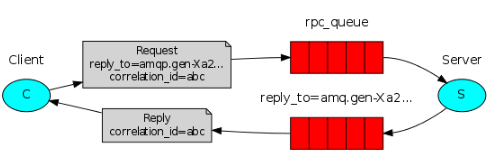RabbitMQ入门(6)——远程过程调用(RPC)
在RabbitMQ入门(2)——工作队列中,我们学习了如何使用工作队列处理在多个工作者之间分配耗时任务。如果我们需要运行远程主机上的某个方法并等待结果怎么办呢?这种模式就是常说的远程过程调用(Remote Procedure Call),简称RPC。
RPC
尽管RPC在计算机中是一种常见的模式,却经常饱受诟病。当程序员不知道方法的调用是本地的还是速度慢的RPC时,可能导致系统不可控、代码难以调试。因此,滥用RPC可能导致代码无法维护。使用RPC的建议:
- 明确方法的调用时本地的还是远程的。
- 提供文档记录,让组件之间的依赖关系清楚明了。
- 记录错误情况,当RPC服务器长时间宕机时,客户端如何处理
当有疑问是,要避免使用RPC,如果可以,尽量使用异步管道结果被异步推到下一个阶段,而不是像RPC那样阻塞。
这一篇我们将使用RabbitMQ建立一个PRC系统:一个客户端和一个可伸缩的PRC服务器。我们将创建一个返回Fibonacci数的虚拟服务。
客户端接口
为了说明RPC如何使用,首先创建一个客户端的类,它暴露一个名为call的方法发送RPC请求,直到收到应答。
FibonacciRpcClient fibonacciRpc = new FibonacciRpcClient();
String result = fibonacciRpc.call("4");
System.out.println( "fib(4) is " + result);
回调队列(Callback queue)
一般来说,在RabbitMQ上执行RPC是比较简单的。客户端发送请求消息,服务器响应消息。为了接收响应,我们需要发送一个带有“回调”队列地址的请求。可以使用默认的队列,它在java客户端具有唯一性。
callbackQueueName = channel.queueDeclare().getQueue();
BasicProperties props = new BasicProperties
.Builder()
.replyTo(callbackQueueName)
.build();
channel.basicPublish("", "rpc_queue", props, message.getBytes());
消息属性(Message properties)
AMQP 0-9-1协议中预先定义了一组14个带有消息的属性。以下几个是比较常用的:
- deliveryMode :将消息标记为持久的(值为2)或瞬态(任何其他值)。
- contentType : 用于描述编码的mime类型。例如,对于经常使用的JSON编码,将该属性设置为:application/JSON是一种很好的做法。
- replyTo : 通常用来命名一个回调队列
- correlationId : 有助于将RPC响应与请求关联起来
关联ID(Correlation Id)
上面的方法中为每一个RPC请求创建一个回调队列的方式效率很低。幸好我们可以为每个客户端创建一个回调队列。然而这又引出了一个新的问题:回调队列中收到的响应我们并不知道是哪个请求发出的。这就是correlationId 属性的作用,我们将为每个请求设置一个唯一的correlationId 。当我们从回调队列收到一条消息时,首先查看correlationId 属性,这样我们就能将请求和响应对应起来了。如果发现一个未知的correlationId,说明它与我们的请求无关,就可以安全地丢弃这条消息了。
也许你会问为什么忽略回调队列的未知消息而不是处理错误?这可能是服务端的竞态条件导致的。RPC服务器可能在发送响应之后,在发送请求的确认消息之前宕机。这就是为什么我们在客户端必须优雅地处理重复的响应,而RPC在理想情况下应该是幂等的。
总结

RPC工作流程:
- 当客户端启动时,它将创建一个匿名的唯一回调队列
- 对于RPC请求,客户端会发送一个包含两个属性的消息,
replyTo属性设置回调队列,correlationId为每一个请求设置唯一的值 - 请求被发送到
rpc_queue队列 - RPC服务器正在等待该队列上的请求,当请求到达时,服务器执行任务并使用replyTo字段的队列将结果返回给客户端。
- 客户端等待回调队列。当消息到达时,首先检查
correlationId属性值,如果它和请求的值匹配,它将返回对应用程序的响应
代码清单
RPCServer:
package com.xxyh.rabbitmq;
import com.rabbitmq.client.*;
import java.io.IOException;
import java.util.concurrent.TimeoutException;
public class RPCServer {
private static final String RPC_QUEUE_NAME = "rpc_queue";
public static void main(String[] args) {
ConnectionFactory factory = new ConnectionFactory();
factory.setHost("localhost");
Connection connection = null;
try {
connection = factory.newConnection();
Channel channel = connection.createChannel();
channel.queueDeclare(RPC_QUEUE_NAME, false, false, false, null);
channel.basicQos(1);
System.out.println("等待RPC请求......");
Consumer consumer = new DefaultConsumer(channel) {
@Override
public void handleDelivery(String consumerTag, Envelope envelope, AMQP.BasicProperties properties, byte[] body) throws IOException {
AMQP.BasicProperties replyProps = new AMQP.BasicProperties
.Builder()
.correlationId(properties.getCorrelationId())
.build();
String response = "";
try {
String message = new String(body,"UTF-8");
int n = Integer.parseInt(message);
System.out.println(" 计算fib(" + message + ")");
response += fib(n);
}
catch (RuntimeException e){
System.out.println(" [.] " + e.toString());
}
finally {
channel.basicPublish( "", properties.getReplyTo(), replyProps, response.getBytes("UTF-8"));
channel.basicAck(envelope.getDeliveryTag(), false);
}
}
};
channel.basicConsume(RPC_QUEUE_NAME, false, consumer);
while (true) {
try {
Thread.sleep(100);
} catch (InterruptedException e) {
e.printStackTrace();
}
}
} catch (IOException e) {
e.printStackTrace();
} catch (TimeoutException e) {
e.printStackTrace();
} finally {
if (connection != null) {
try {
connection.close();
} catch (IOException e) {
e.printStackTrace();
}
}
}
}
private static int fib(int n) {
if (n == 0) {
return 0;
}
if (n == 1) {
return 1;
}
return fib(n - 1) + fib(n - 2);
}
}
RPCClient:
package com.xxyh.rabbitmq;
import com.rabbitmq.client.*;
import java.io.IOException;
import java.io.UnsupportedEncodingException;
import java.util.UUID;
import java.util.concurrent.ArrayBlockingQueue;
import java.util.concurrent.BlockingQueue;
import java.util.concurrent.TimeoutException;
public class RPCClient {
private static final String RPC_QUEUE_NAME = "rpc_queue";
private Connection connection;
private Channel channel;
private String replyQueueName;
public RPCClient() throws IOException, TimeoutException {
ConnectionFactory factory = new ConnectionFactory();
factory.setHost("localhost");
connection = factory.newConnection();
channel = connection.createChannel();
replyQueueName = channel.queueDeclare().getQueue();
}
public String call(String message) throws IOException, InterruptedException {
String corrId = UUID.randomUUID().toString();
AMQP.BasicProperties props = new AMQP.BasicProperties
.Builder()
.correlationId(corrId)
.replyTo(replyQueueName)
.build();
channel.basicPublish("", RPC_QUEUE_NAME, props, message.getBytes("utf-8"));
final BlockingQueue<String> response = new ArrayBlockingQueue<>(1);
channel.basicConsume(replyQueueName, true, new DefaultConsumer(channel) {
@Override
public void handleDelivery(String consumerTag, Envelope envelope, AMQP.BasicProperties properties, byte[] body) throws IOException {
if (properties.getCorrelationId().equals(corrId)) {
response.offer(new String(body, "utf-8"));
}
}
});
return response.take();
}
public void close() throws IOException {
connection.close();
}
public static void main(String[] args) {
RPCClient fibonacciRpc = null;
String response = null;
try {
fibonacciRpc = new RPCClient();
System.out.println(Thread.currentThread().getName() + " 请求 fib(30)");
response = fibonacciRpc.call("30");
System.out.println(Thread.currentThread().getName() + " 获得结果: " + response);
} catch (IOException e) {
e.printStackTrace();
} catch (TimeoutException e) {
e.printStackTrace();
} catch (InterruptedException e) {
e.printStackTrace();
} finally {
if (fibonacciRpc != null) {
try {
fibonacciRpc.close();
} catch (IOException e) {
e.printStackTrace();
}
}
}
}
}


